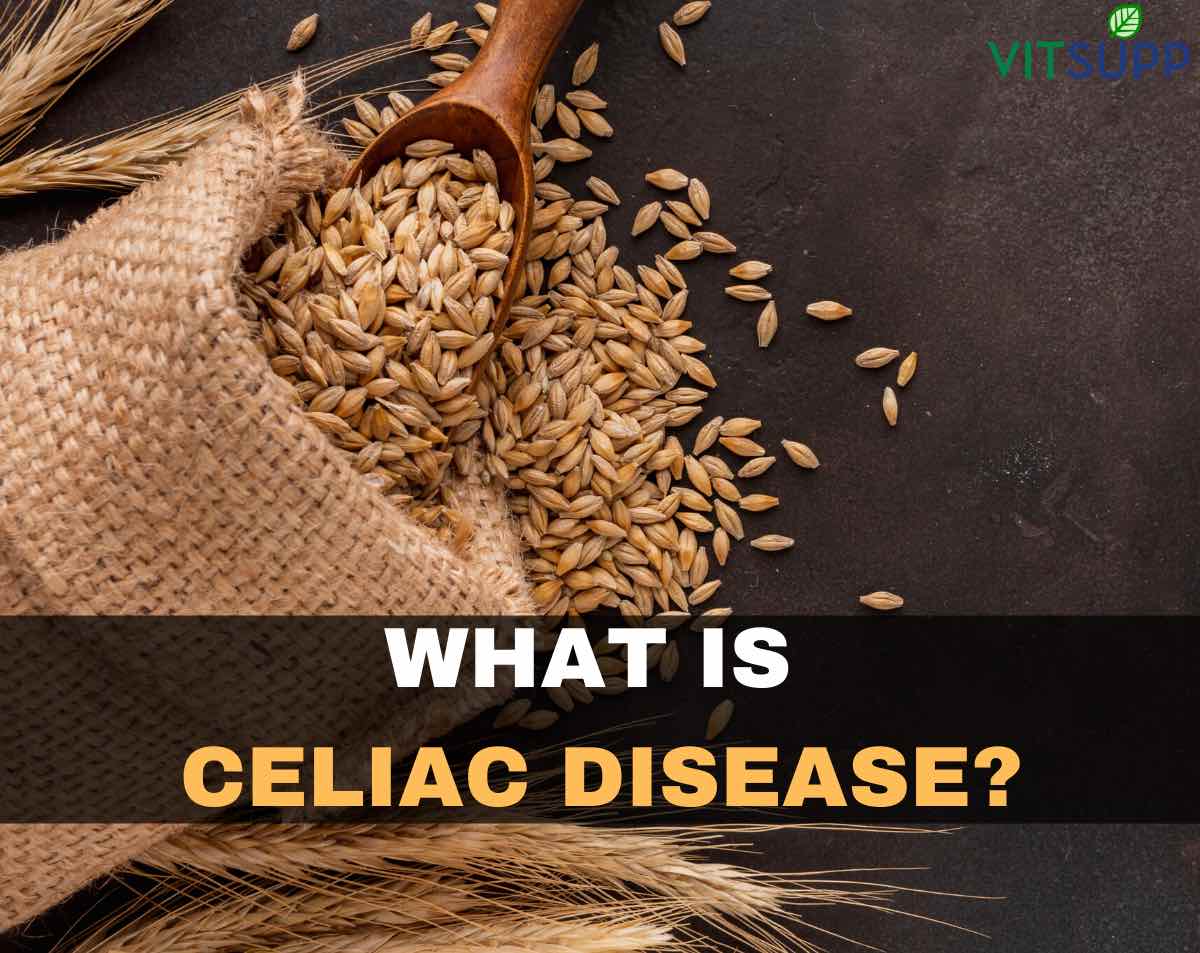Many health-conscious people today are aware of heart ailments, diabetes, digestive and kidney diseases. However, not many people know about celiac disease.
It is estimated that one in every 100 people suffer from this medical condition. The main culprit responsible for this disease is gluten, which is why there is a rise in the number of stores and food products that are labelled as ‘gluten-free’ are growing in number by the minute.
But what exactly is celiac disease, and what does gluten have to do with it?
Contents
What is celiac disease?
Gluten is a type of protein found in grains such as wheat, barley, spelt and rye.
Celiac disease is an autoimmune disorder, where your body has an adverse reaction to the consumption of gluten. When a person suffering from celiac disease eats gluten, the body begins to develop an immune response in the small intestine.
The small intestines contain finger like-small projections known as the villi. The function of the villi is to absorb the nutrients that you get from the food you consume, into the body. Celiac disease can damage the villi.
Over time, the body becomes unable to absorb nutrients from the food to your body. Celiac disease can cause serious digestive problems and consequently nutrition deficiencies.
Celiac disease is also called celiac disease. Other common names are non-tropical sprue, celiac sprue, and gluten-sensitive enteropathy. (source)
How common is celiac disease?
It has been estimated that close to one in every hundred people suffer from celiac disease globally. Despite this fact, most cases go undiagnosed. If not treated, celiac disease can lead to serious health complications in the long run.
It has been observed that those who suffer from celiac disease are two times at risk of suffering from coronary artery ailments.
Another estimation is that people who are suffering from celiac disease are four times at risk of developing cancers, particularly small bowel cancers.
Other long term health conditions associated with celiac disease are:
- Iron deficiency anaemia (source)
- Pancreatic insufficiency (source)
- Lactose intolerance (source)
- Gallbladder malfunction (source)
- Intestinal lymphomas (source)
- Mineral and vitamin deficiencies (source)
- Miscarriages and infertility (source)
- Neurological disorders – like migraine, dementia, neuropathy, ataxia, and myopathy. (source)
Celiac disease is the kind of disease that is hereditary. Your chances of getting the celiac disease are more if a first-degree relative is already suffering from it. (source)
Celiac disease definition
According to the National Institute of Diabetes and Digestive and Kidney Disease, celiac disease is defined as –
Celiac disease is a digestive disorder that damages the small intestine. When you have celiac disease, eating foods containing gluten can trigger a severe reaction. (source)
Celiac disease can be very serious. The disease can cause long-lasting digestive problems and keep your body from getting all the nutrients it needs. Celiac disease can also affect the body outside the intestine. (source)
Celiac disease is also called coeliac disease. Other common names are non-tropical sprue, celiac sprue, and gluten-sensitive enteropathy. (source)
Celiac disease CAUSES
Celiac disease can develop at any given time in your life. The exact cause of the celiac disease is not known yet. However, there are several factors that can contribute to the development of this disease.
Some of these causal factors are gastrointestinal disorders, infant-feeding practices, viral infections, pregnancy and childbirth, severe emotional stress, and the accumulation of gut bacteria. In some cases, celiac disease can develop after a particular surgery as well.
Some people are more at risk of developing celiac disease than the rest.
The list below highlights these risk factors
- People who are suffering from type 1 diabetes
- Those with autoimmune thyroid disease
- If you have a family member who is suffering from celiac disease
- In case a family member is suffering from dermatitis herpetiformis
- People who are suffering from Addison’s disease
- Those who have microscopic colitis (lymphocytic or collagenous colitis) (23)
Some research suggests that celiac disease affects people who have a genetic predisposition towards the same.
Over one-third of the global population is genetically prone to develop celiac disease. This is how common the disorder is. (2)
Celiac disease symptoms
In most cases, if you are suffering from celiac disease, you will experience one or more of the possible symptoms. In a few cases, the individual may not experience any symptoms.
Since celiac disease affects the digestive system the most, you are bound to face symptoms that are associated with the digestive system.
Celiac disease symptoms in adults
The symptoms that are associated with the digestive system are – (source)
- Blockages in the intestines (source)
- Inflammation or ulcers in the lining of the stomach (source)
- Pain in the abdomen (source)
- Abdominal bloating (source)
- Brain fog (source)
- Fatigue that lasts for extended periods of time (source)
Adults can experience symptoms that are not associated with the digestive tract as well. These are as follows –
- Pain in the joints and bones (source)
- Brittle and weak bones (source)
- Infertility (source)
- Miscarriages (source)
- Irregular periods (source)
- Canker sores or dry mouth (source)
- Unexplained headaches (source)
- Seizures (source)
- Anxiety (source)
- Depression (source)
Celiac disease symptoms in children
Children are more prone to digestive symptoms than adults. The symptoms that they are likely to experience are listed below. (5)
- Chronic diarrhoea
- Gas and bloating
- Foul-smelling and pale stools which float
- Stomach ache
- Constipation
- Vomiting
Celiac disease diagnosis in adults
Unfortunately, celiac disease is initially hard to diagnose. This is because most of the symptoms that are related to celiac disease are similar to that of other diseases like lactose intolerance and irritable bowel syndrome. To diagnose you, the healthcare professional will first look into your medical history as well as your family medical history to see if you are genetically predisposed to develop celiac disease. This is done with the help of genetic testing.
We have listed below a few tests that can help with the diagnosis of celiac disease –
1. Physical examination
A physical examination is conducted to check for symptoms of celiac disease. During a physical examination, the doctor will do check you for any rashes, swelling, or pain in your body, particularly in the stomach and abdomen areas. The doctor will also look for signs of malnutrition or vitamin and mineral deficiencies. (6) (7)
2. Dental examinations
This might come as a surprise, but a dental examination could help diagnose celiac disease as well. This is because teeth can get affected by celiac disease. When you are suffering from celiac disease, your intestines are unable to absorb the nutrients that your body needs.
No matter what you eat or how much you eat, you will not get the nutrients. Eventually, your teeth bear the brunt of this as well. People who suffer from celiac disease often experience brown or yellow spots on the teeth, defects on the tooth enamel, and weak or lose teeth. A dental examination can determine the cause of all this, which could be celiac disease. (8) (9)
3. Blood tests
Often, blood tests are administered to check for the positivity of celiac disease. A blood sample is usually taken to check for any antibodies that might be common in those suffering from celiac disease.
In some cases, like when the results are negative, the lab specialist or doctors might ask you to undergo more blood tests. This is if the doctor suspects that you are suffering from celiac disease. (10) (11)
4. Skin biopsy
Dermatitis herpetiformis is a skin condition associated with celiac disease. In fact, it is the manifestation of this disorder on your skin. It is characterised by intense itching, rashes and blisters, or recurring breakouts on the elbows and knees. Studies estimate that over 15 to 25 per cent of people who suffer from celiac disease also suffer from dermatitis herpetiformis.
A skin biopsy is often conducted to check if you are suffering from dermatitis herpetiformis. During the skin biopsy, the doctor usually takes a small sample of your skin or the skin tissue. One of the results are out, the doctor will determine if you have celiac disease.
The doctor might additionally ask you to undergo a few blood tests to confirm the presence of antibodies that might prove that you are suffering from celiac disease. If the tests are negative and the doctor suspects that you need more tests, he may recommend an intestinal biopsy. (12)
5. Intestinal biopsy
Since celiac disease affects the intestine the most, and intestinal biopsy is recommended. Diagnosticians conduct a procedure known as upper GI endoscopy to take a small sample of the tissues in your intestines. They then use this sample to check for antibodies and to aid with the diagnosis of celiac disease. (13)
Celiac disease treatment options
Till date, the only way that has been identified to treat celiac disease is by making a switch to a gluten-free diet. A gluten-free diet is one that does not contain products that have gluten, like wheat, barley, and rye.
You will have to ask your doctor to recommend a reliable dietician to help you understand and identify the foods that might have gluten. You will also require an everyday meal plan.
A dietician will help you identify food labels as well, so you can steer clear of them. We have listed foods that contain gluten and food labels that you should be wary of below.
Foods that contain gluten
- Wheat
- Barley
- Rye
- Graham Flour
- Bulgur
- Semolina
- Triticale
- Malt
- Durham (source)
Products that might contain gluten in them
- Food products, stabilizers, and modified food products that contain starch
- Certain vitamin and mineral supplements
- Nutritional supplements
- Herbal supplements
- Lipsticks
- Toothpaste
- Mouthwash
- Glue
- Certain over the counter drugs and medications
- Playdough
- Wafers and communion wafers
To treat celiac disease, your doctor might also administer a few supplements to you. This is to make up for all the nutrients that your body is unable to absorb. These supplements include copper, iron, folate, Vitamin D, Vitamin K, Vitamin B-12, and zinc.
While these supplements usually come in the form of capsules or pills, if your body still refuses to absorb it, in worst-case scenarios, the doctor might prescribe the same in the form of injections. (source)
Celiac disease treatment in Ayurveda
Ayurvedic treatment is available for celiac disease. While undergoing treatment in Ayurveda, you will be given certain herbs and concoctions. Most ayurvedic treatments target immune cells. To treat the abnormal functioning of the immune cells, the Ayurvedic doctors administer certain herbal remedies, along with detoxification procedures to the patient. (15)
Celiac disease treatment in Homeopathy
The fundamental ideology of homoeopathy is that the body is fully capable of curing itself. To aid this process, certain homeopathys use minerals and vitamins, as well as plant substances. To treat celiac disease, homeopaths follow the same approach.
Usually, to treat watery stool and diarrhoea associated with celiac disease, in homoeopathy, the patient has to consume Natrum Sulph. A substance called China is given to treat fatigue. Homeopathy practitioners use kali carb and lycopodium to treat bloating and excess gas in the abdomen. (14)
Celiac disease diet
If you are suffering from celiac disease, then it is advisable to begin a celiac disease diet. Quite simply, a celiac disease diet is one that contains absolutely no gluten. Since several foods like bread, pasta, and noodles contains gluten, you might think that you have to put an end to consuming all this because you have a gluten intolerance.
But this is not necessary as there are many food stores that provide gluten-free bread, pasta, and other foods as well. Many times, doctors recommend eating oats as a substitute. Rice too is a gluten-free substitute to grains like wheat and barley. Here are a few gluten-free products-
Gluten-free products
- Vegetables and fruits
- Fish and seafood
- Meat and Poultry
- Dairy products
- Cassava
- Rice
- Beans
- Quinoa
- Millet
- Corn
- Sorghum
- Tapioca
- Potato
- Arrowroot
- Flax
- Chia
- Amarnath
- Buckwheat or kasha
- Oats
- Yucca (18)
Celiac and diabetes
There is no direct relationship between diabetes and celiac disease. However, the occurrence of diabetes can pave the way to the development of celiac disease, and vice versa. Both diabetes and celiac disease are autoimmune disorders.
Estimates say that close to 6% of people who suffer from type 1 diabetes, eventually end up with celiac disease as well. Till date, scientists have found no link between celiac disease and type 2 diabetes. (source)
In conclusion
If you have celiac disease, try to get a reliable dietician or nutritionist to advise you about the required lifestyle and dietary changes. People with celiac disease will have to consider switching to a gluten-free diet to avoid long-term health risks. Gluten is present in many common foods like bread, pasta, noodles, cakes, and pastries, but there are several gluten-free substitutes as well.
If you suspect that you or a known person is suffering from celiac disease, make sure you take the necessary tests to diagnose this condition. Since celiac disease is an autoimmune disorder, it can pave the way to a long list of other diseases and disorders as well. You can avoid this if you detect the condition early and get the necessary treatment.
Celiac disease meaning in Hindi
सीलिएक रोग एक ऑटोइम्यून विकार है, जहां आपके शरीर में लस की खपत पर प्रतिकूल प्रतिक्रिया होती है। जब सीलिएक रोग से पीड़ित व्यक्ति ग्लूटेन का सेवन करता है, तो ऑटोइम्यून सिस्टम अधिक होने लगता है और फिर प्रतिक्रिया के रूप में पाचन तंत्र को नुकसान पहुंचाना शुरू कर देता है।
सीलिएक रोग को सीलिएक रोग भी कहा जाता है। अन्य सामान्य नाम गैर-उष्णकटिबंधीय स्प्रू, सीलिएक स्प्रू और ग्लूटेन-सेंसिटिव एंटरोपैथी हैं।
FAQ’S
What is celiac disease?
Celiac disease is an autoimmune disorder, where your body has an adverse reaction to the consumption of gluten. When a person suffering from celiac disease eats gluten, the body begins to develop an immune response in the small intestine.u003cbru003eThe small intestines contain finger like-small projections known as the villi. The function of the villi is to absorb the nutrients that you get from the food you consume, into the body. Celiac disease can damage the villi.
What causes celiac disease?
Celiac disease can develop at any given time in your life. The exact cause of the celiac disease is not known yet. However, there are several factors that can contribute to the development of this disease.u003cbru003eSome of these causal factors are gastrointestinal disorders, infant-feeding practices, viral infections, pregnancy and childbirth, severe emotional stress, and the accumulation of gut bacteria. In some cases, celiac disease can develop after a particular surgery as well.u003cbru003eSome people are more at risk of developing celiac disease than the rest.u003cbru003eThe list below highlights these risk factorsu003cbru003e1 People who are suffering from type 1 diabetesu003cbru003e2 Those with autoimmune thyroid diseaseu003cbru003e3 If you have a family member who is suffering from celiac diseaseu003cbru003e4 In case a family member is suffering from dermatitis herpetiformisu003cbru003e5 People who are suffering from Addison’s diseaseu003cbru003e5 Those who have microscopic colitis (lymphocytic or collagenous colitis) u003ca href=u0022https://www.niddk.nih.gov/health-information/digestive-diseases/celiac-disease/symptoms-causesu0022u003e(source)u003c/au003eu003cbru003eSome research suggests that celiac disease affects people who have a genetic predisposition towards the same.
What is the celiac disease in hindi?
Celiac disease को हिंदी मैं सीलिएक रोग के नाम से जाना जाता है। इस रोग का कोई भारतीय नाम नहीं है। यह एक ऑटोइम्यून विकार है, जहां आपके शरीर में लस की खपत (Gluten consumption) पर प्रतिकूल प्रतिक्रिया होती है। जब सीलिएक रोग से पीड़ित व्यक्ति ग्लूटेन खाता है, तो शरीर छोटी आंत में प्रतिरक्षा प्रतिक्रिया विकसित करना शुरू कर देता है। u003cbru003eछोटी आंतों में आपके द्वारा खाए गए भोजन से पोषण का अवशोषण होता है। अगर आप को celiac disease है तो समय के साथ आपकी छोटी आँत भोजन से पोषक तत्वों को आपके शरीर में अवशोषित करने में असमर्थ हो जाता है। सीलिएक रोग गंभीर पाचन समस्याओं और इसके परिणामस्वरूप पोषण संबंधी कमियों का कारण बन सकता है।
What is celiac disease treatment in ayurveda in hindi?
सीलिएक रोग के लिए आयुर्वेदिक उपचार उपलब्ध है। आयुर्वेद में उपचार के दौरान, आपको कुछ निश्चित जड़ी-बूटियाँ दी जाती है। अधिकांश आयुर्वेदिक उपचार प्रतिरक्षा कोशिकाओं को लक्षित करते हैं। प्रतिरक्षा कोशिकाओं के असामान्य कामकाज का इलाज करने के लिए, आयुर्वेदिक डॉक्टर रोगी को डिटॉक्सिफिकेशन प्रक्रियाओं के साथ, कुछ हर्बल उपचारों का प्रबंधन करते हैं।
List major celiac symptoms.
Major celiac symptoms are as follows: u003cbru003e 1 Blockages in the intestinesu003cbru003e 2 Inflammation or ulcers in the lining of the stomachu003cbru003e 3 Pain in the abdomenu003cbru003e 4 Abdominal bloatingu003cbru003e 5 Brain fogu003cbru003e 6 Fatigue that lasts for extended periods of timeu003cbru003e Adults can experience symptoms that are not associated with the digestive tract as well. These are as follows –u003cbru003e 7 Depressionu003cbru003e 8 Pain in the joints and bones u003cbru003e 9 Brittle and weak bonesu003cbru003e 10 Infertility u003cbru003e 11 Miscarriagesu003cbru003e 12 Irregular periods u003cbru003e 13 Canker sores or dry mouth u003cbru003e 14 Unexplained headaches u003cbru003e 15 Seizures u003cbru003e 16 Anxiety


